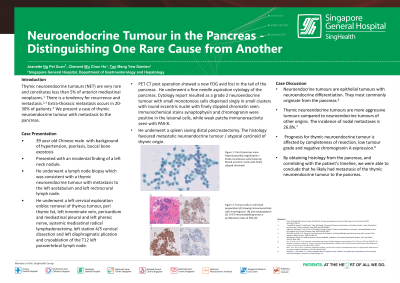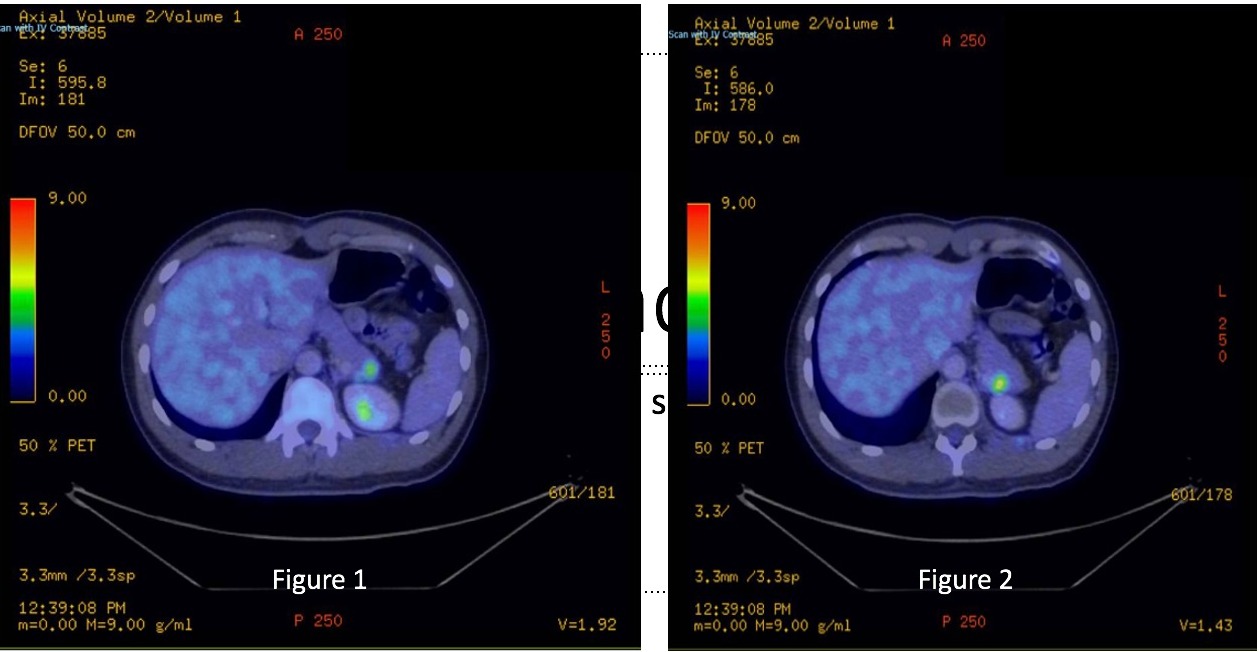Tuesday Poster Session
Category: Biliary/Pancreas
P2956 - Neuroendocrine Tumor in the Pancreas - Distinguishing One Rare Cause from Another
Tuesday, October 24, 2023
10:30 AM - 4:00 PM PT
Location: Exhibit Hall

Has Audio
- JN
Jeanette Pei Xuan Ng, MBBS, MRCP
Singapore General Hospital
Singapore, Singapore
Presenting Author(s)
Jeanette Pei Xuan. Ng, MBBS, MRCP1, Damien Meng Yew Tan, MBBS, MRCP2, Clement Chun Ho. Wu, MBBS, MRCP1
1Singapore General Hospital, Singapore, Singapore; 2Singhealth, Singapore, Singapore
Introduction: Neuroendocrine tumors (NETs) are an uncommon cause of a pancreatic mass. Distinguishing a primary neuroendocrine tumor of the pancreas from a neuroendocrine metastasis from a different site is important for prognostication and treatment. We present a case of thymic neuroendocrine tumor with metastasis to the pancreas.
Case Description/Methods: A 39 year old Chinese male with first presented with an incidental left neck swelling. Fine needle aspiration cytology showed round cells. A positron emission tomography (PET) scan showed a thymic mass with oligometastasis to the left cervical lymph node. He underwent a radical mediastinal thymectomy with regional lymphadenectomy and a left cervical station 4/5 dissection. Histology showed nests of round to ovoid cells with a Ki67 proliferative fraction of 25-30% and patchy PAX8 immunoreactivity - confirming the diagnosis of a grade 2 thymic NET. He subsequently underwent adjuvant chemoradiotherapy.
A PET scan performed 12 months post operatively showed a new FDG-avid foci in the pancreatic tail. EUS-FNB showed round cells with Ki67 proliferative fraction of 25-30% suggestive of grade 2 NET - however the origin of this NET was uncertain. The patient elected to proceed with a spleen-saving distal pancreatectomy. The histology from the distal pancreas lesion was compared to the histology from the left cervical node dissection. Both tumours show similar histological features of proliferative round to ovoid cells with speckled chromatin and patchy PAX8 immunoreactivity. Multidiscplinary consensus favored a metastatic neuroendocrine tumor of thymic origin. The patient was continued on adjuvant chemoradiotherapy, and remains well.
Discussion:NETs originate most commonly from the pancreas. Thymic NETs are rarer and more aggressive than NETs originating from other sites. Metastasis of a thymic NET to the pancreas is exceedingly rare. Distinguishing a second primary NET in the pancreas from a metastatic NET lesion is important for prognostication and subsequent treatment – especially in our patient who had a history of both thymic and pancreatic NET. Extent of PAX8 immunoreactivity and multidisciplinary consensus aids clinicopathological correlation – which is crucial for obtaining the correct diagnosis and ensuring optimal care.
1Singapore General Hospital, Singapore, Singapore; 2Singhealth, Singapore, Singapore
Introduction: Neuroendocrine tumors (NETs) are an uncommon cause of a pancreatic mass. Distinguishing a primary neuroendocrine tumor of the pancreas from a neuroendocrine metastasis from a different site is important for prognostication and treatment. We present a case of thymic neuroendocrine tumor with metastasis to the pancreas.
Case Description/Methods: A 39 year old Chinese male with first presented with an incidental left neck swelling. Fine needle aspiration cytology showed round cells. A positron emission tomography (PET) scan showed a thymic mass with oligometastasis to the left cervical lymph node. He underwent a radical mediastinal thymectomy with regional lymphadenectomy and a left cervical station 4/5 dissection. Histology showed nests of round to ovoid cells with a Ki67 proliferative fraction of 25-30% and patchy PAX8 immunoreactivity - confirming the diagnosis of a grade 2 thymic NET. He subsequently underwent adjuvant chemoradiotherapy.
A PET scan performed 12 months post operatively showed a new FDG-avid foci in the pancreatic tail. EUS-FNB showed round cells with Ki67 proliferative fraction of 25-30% suggestive of grade 2 NET - however the origin of this NET was uncertain. The patient elected to proceed with a spleen-saving distal pancreatectomy. The histology from the distal pancreas lesion was compared to the histology from the left cervical node dissection. Both tumours show similar histological features of proliferative round to ovoid cells with speckled chromatin and patchy PAX8 immunoreactivity. Multidiscplinary consensus favored a metastatic neuroendocrine tumor of thymic origin. The patient was continued on adjuvant chemoradiotherapy, and remains well.
Discussion:
NETs originate most commonly from the pancreas. Thymic NETs are rarer and more aggressive than NETs originating from other sites. Metastasis of a thymic NET to the pancreas is exceedingly rare. Distinguishing a second primary NET in the pancreas from a metastatic NET lesion is important for prognostication and subsequent treatment – especially in our patient who had a history of both thymic and pancreatic NET. Extent of PAX8 immunoreactivity and multidisciplinary consensus aids clinicopathological correlation – which is crucial for obtaining the correct diagnosis and ensuring optimal care.

Figure: Figure 1 FDG avid foci in tail of pancreas (SUVmax4.2)
Figure 2 FDG avid foci in tail of pancreas (SUVmax4.2)
Disclosures:
Jeanette Ng indicated no relevant financial relationships. Damien Meng Yew Tan: Boston Scientific – Speakers Bureau. Pentax Medical – Speakers Bureau.Clement Wu indicated no relevant financial relationships.
Jeanette Pei Xuan. Ng, MBBS, MRCP1, Damien Meng Yew Tan, MBBS, MRCP2, Clement Chun Ho. Wu, MBBS, MRCP1. P2956 - Neuroendocrine Tumor in the Pancreas - Distinguishing One Rare Cause from Another, ACG 2023 Annual Scientific Meeting Abstracts. Vancouver, BC, Canada: American College of Gastroenterology.

Figure 2 FDG avid foci in tail of pancreas (SUVmax4.2)
